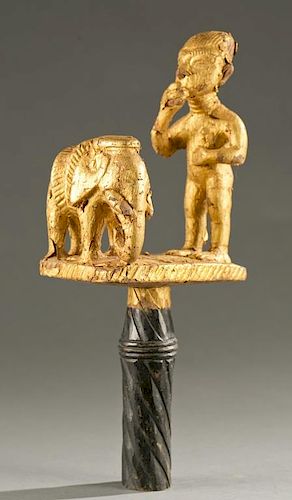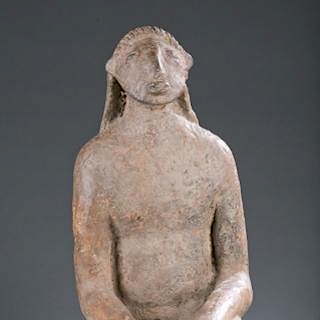Asante linguist gold leaf staff finial, 20th c.
Lot 64
About Seller
Quinn's Auction Galleries
360 S. Washington Street
Falls Church, VA 22046
United States
Quinn's Auction Galleries is a full service auction and estate services company. We have a range of specialties, from fine art & antiques, to rare books & maps.
Categories
Estimate:
$200 - $400
Absentee vs Live bid
Two ways to bid:
- Leave a max absentee bid and the platform will bid on your behalf up to your maximum bid during the live auction.
- Bid live during the auction and your bids will be submitted real-time to the auctioneer.
Bid Increments
| Price | Bid Increment |
|---|---|
| $0 | $10 |
| $300 | $25 |
| $500 | $50 |
| $1,000 | $100 |
| $3,000 | $250 |
| $5,000 | $500 |
| $15,000 | $1,000 |
| $20,000 | $2,000 |
| $30,000 | $2,500 |
| $100,000 | $5,000 |
About Auction
By Quinn's Auction Galleries
Oct 1, 2016 - Oct 2, 2016
Set Reminder
2016-10-01 11:00:00
2016-10-02 11:00:00
America/New_York
Bidsquare
Bidsquare : Estate of Merton Simpson & Multi Estate Ethnographic
https://www.bidsquare.com/auctions/quinns/estate-of-merton-simpson-multi-estate-ethnographic-1779
Quinn's Auction Galleries dquinn@quinnsauction.com
Quinn's Auction Galleries dquinn@quinnsauction.com
- Lot Description
A linguist gold leaf staff finial with a standing male figure and an elephant. Ghana, Asante. 20th century. 15 1/2"h x 3 3/4"w x 6 1/2"d.
Provenance: Inventory and Collection from the Estate of Merton D. Simpson. Catalog Notes: Spectacular staffs covered in thick gold leaf or sheeting were carried by members of high social standing in the courts of Akan chiefs in West Africa. The society originally had no tradition of written word and therefore placed huge significance on the speech. Individuals who had the best command of language could be appointed as court linguist, a position of high honor. The staff carried by linguists often portrayed proverbs and stories realted to their abilties. For a similar object see The Metropolitain Museum of Art, "Linguist Staff (Okyeame)", 19th-early 20th century, 1986.475a-c. Gold working techniques such as lost-wax casting and methods of covering an object with gold are of considerable antiquity among the Akan-speaking peoples of Ghana and the Ivory Coast. They were probably introduced by Mande-speaking traders from the north during the Akan-Mande gold trade before European contact, although Akan techniques for the application of sheet gold to wood or other support material may be local inventions. The earliest European reports indicate that gold-working was already well-established; many describe cast gold ornaments and the English trader John Lock noted "foresleeves of beaten gold" worn on the bare arms of wealthy Akan women at the coast in 1554 (Garrard: 107). In 1673, Wilhelm Mueller reported the regalia of a coastal Akan leader as being covered with "fine beaten gold" (Garrard: 108). The Golden Stool itself is composed entirely of thick gold plates and is hollow, but is certainly based upon a wood prototype; it is probably safe to assume that the original wood carving disappeared long ago, leaving a substantial gold shell. Asante tradition dates the stool to the formation of the Asante state, around 1700. By 1817, the English diplomat T. E. Bowdich noted some window frames "cased with thin gold" in Asantehene Osei Bonsu's Kumasi palace (Bowdich: 57), while the royal musical instruments were "cased in gold, about the thickness of cartridge paper" (Bowdich: 38--39). Lavish Asante use of sheet gold over wood or leather continued until after 1874 and the English defeat of Asantehene Kofi Kakari, though after that date less of it is to be found, and it is often done in thinner metal. It is really proper to describe much Asante "gold leaf" as "gold sheet" because it is often as thick as a thin sheet of paper--many times the thickness of European gold leaf--and is consequently far easier to handle. It is often found in rectangular pieces about an inch and a half long and three-quarters of an inch wide, made locally. In the 19th and early 20th centuries it was attached to a wood support with tiny staples made of gold wire, but sometime after 1950 European glues were used for thinner gold coverings. Akan peoples of the Ivory Coast did not use staples; gold coverings on wood or leather were much thinner and were glued on, reflecting the lesser amount of gold available there. However, the gold "leaf" is still thicker than European gold leaf and is produced locally, by hand. Dr. Martha J. Ehrlich --------------------------- Bowdich, T. E. : "Mission from Cape Coast Castle to Ashantee"; London: 1819 Garrard, T. F. : "Akan Weights and the Gold Trade"; London and New York: Longman, 1980 - Shipping Info
-
Shipping and Handling Policy:
Quinn's Auctions ONLY ships with FedEx Domestic and USPS internationally. We do not ship Media Mail. Shipping costs are based on the weight of your lots and your location. We require a complete shipping address and phone number to process your shipping quote. You will receive your shipping quote in your invoice via your registered email with a tracking number if available. Once payment is received Quinns will ship items FedEx ground in the United States, USPS International or release items to an outside shipper.Quinn's Auctions reserves the right to recommend an outside shipper based on fragility and size of lot. We offer recommendations for outside shipping by trusted shippers if necessary. If using an outside shipper Quinn's Auctions is not responsible for damages by carriers or packers of purchased lots, whether or not recommended by Quinn's Auctions and will not be liable for any losses which result.
-
- Buyer's Premium



 EUR
EUR CAD
CAD AUD
AUD GBP
GBP MXN
MXN HKD
HKD CNY
CNY MYR
MYR SEK
SEK SGD
SGD CHF
CHF THB
THB

















